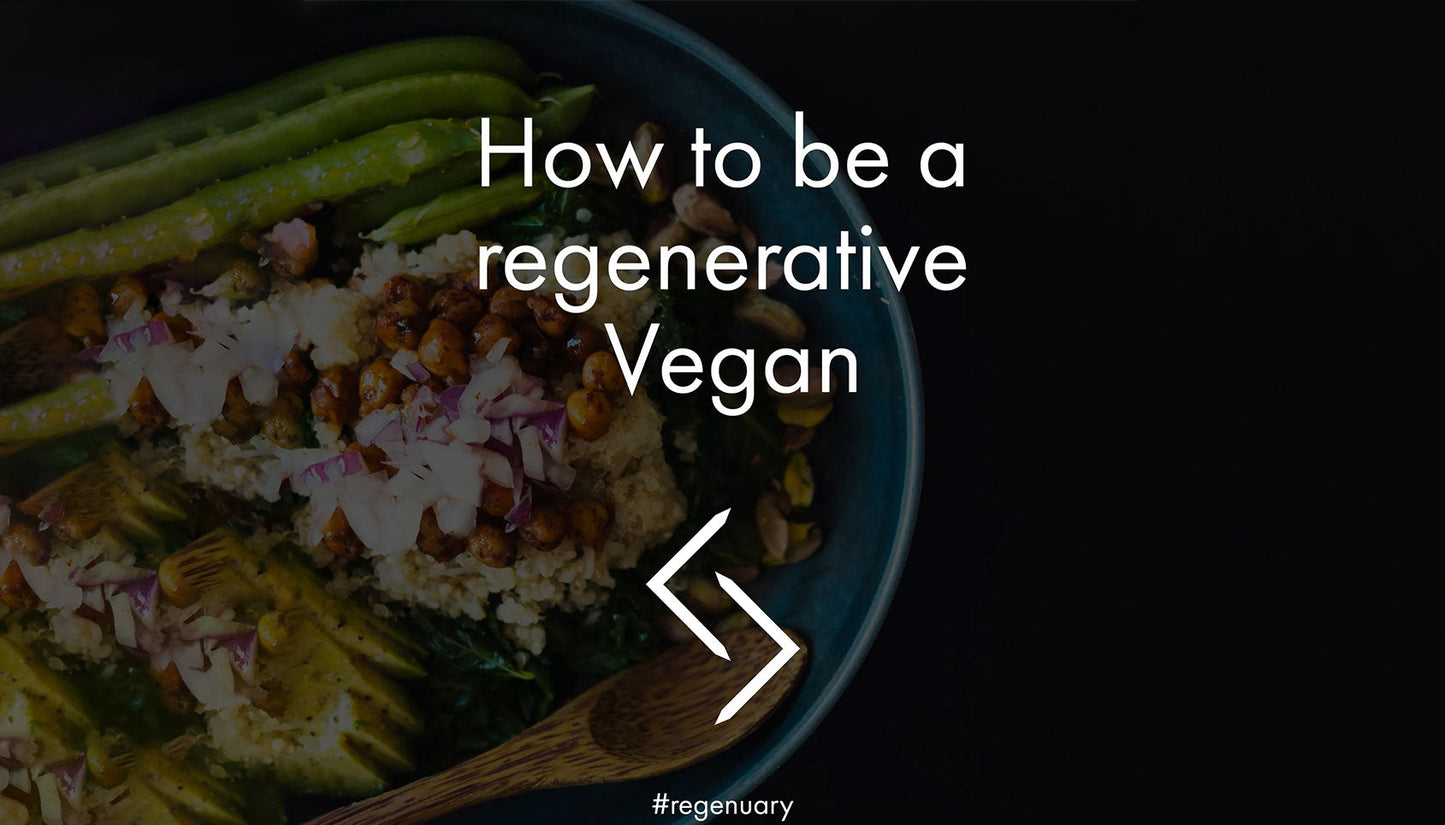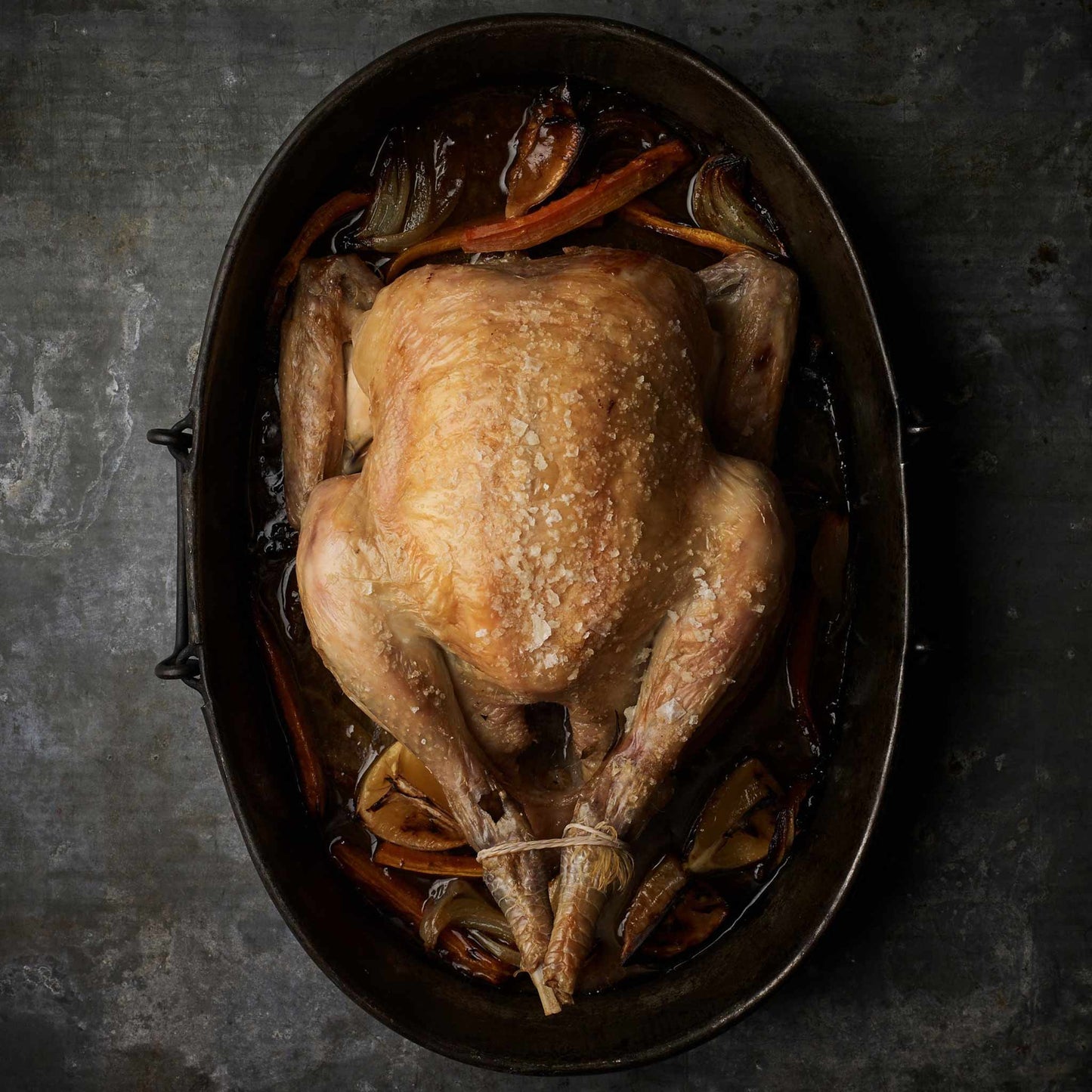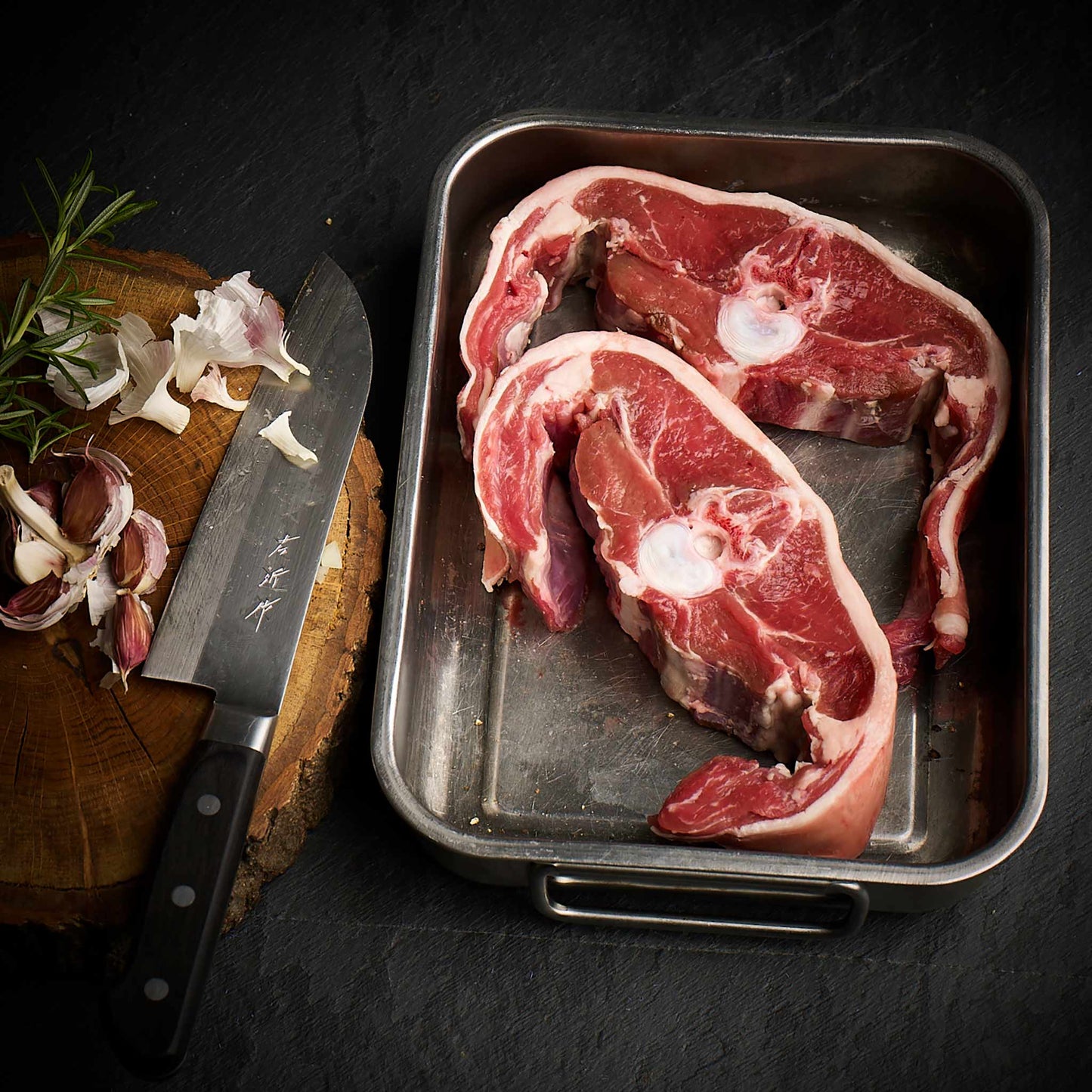We source our chicken from one farm in Leicestershire. The farm is Pasture for Life certified and rears truly free range, outdoor birds.

We've been very critical of Veganuary for not providing participants with information that could help them to reduce impact, so we thought we would try and help by offering our guide to being a regenerative vegan. As it is Veganuary now, we will look at this in the context of January and living in the UK.
Unfortunately, this piece will have to start with a huge section of complex definitions before we get to be able to answer the question, so please bear with us...
How do we define vegan foods for this piece?
Veganism is defined as 'a way of living which seeks to exclude, as far as possible and practical, all forms of exploitation of, and cruelty to, animals'. For this article, we will look at the dietary element as it prohibits the consumption of any animal-based food, which includes meats, fish, seafood, eggs from either birds or fish, milk and any milk-based products such as cheeses, yoghurts and butter and honey. It does not however exclude any organically grown vegetable that was fertilised with animal manure, blood or bone meal in an organic system.
What do we mean by regenerative foods?
In terms of this article, it means sourcing foods that have been produced in conditions that include building soil health and fertility, increasing water percolation and retention, increasing biodiversity and ecosystem health, and reducing carbon emissions and current atmospheric CO2 levels.
So how is this actually achieved in arable crop production?
By arable we mean any land that is used for growing crops, be it grains, fruits, seeds, nuts, vegetables or fruits, we are not including the use of hydroponic or vertical farming systems as these are far from regenerative; they have no interaction with an ecosystem and yet require the use of inputs, power and extensive infrastructure.
Isn't all organic produce regenerative?
Organic production is defined by a producer following a set of criteria to achieve certification. Organic farmers work to a strict set of standards, which must legally comply with strict EU regulations.
Under the Soil Association’s organic standards, all weedkillers are banned, and farmers are only able to use a very limited number of naturally derived pesticides, which means the damaging herbicide Glyphosate (Roundup) cannot be used. Instead of relying on pesticides, organic farmers aim to create a natural balance between plants and animals to prevent pests.
Organic farming avoids the use of synthetic fertilisers, as the principles of organic farming are based on nourishing plants naturally, by building fertile soils. Farmers do this using clover and legumes to fix nitrogen as well as using compost, animal manure and green manures.
Another key tenet of the organic standard is that no genetically modified plant can be grown (GMO).
So organic is defined by a checklist of 'dos' and 'don'ts' and these standards are undoubtedly beneficial, but is it regenerative?
Not necessarily, but maybe.
The difference between organic and regenerative is that 'regenerative agriculture is about principles, not practices. It focuses on outcomes — actual improvements to soil health and the overall quality and health of the land (the soil, water, plants, animals and humans).
Regenerative agriculture is an adaptive management approach that is supported by soil health principles. There is no recipe or prescription because each farm or ranch differs based on unique natural resources, climate variability, and animal and ecological dynamics. Producers apply those principles for their particular region, operation and personal situation.
This freedom for producers to make decisions on their land is important. The reality is that working with nature is complex. There are good practices that if applied at the wrong time or under the wrong conditions can hurt, not help the land.' - Taken from Noble.org
Now let's ask the question backwards: is regenerative organic?
Again, not necessarily, but maybe. It is possible to be regenerative without being certified organic.
So what is veganic and is that regenerative?
Veganic agriculture in a nutshell is organic without the use of any animal products. Within organic agriculture, since chemical fertilisers are banned, animal manure, bone meal and blood as by-products of the meat industry are used instead, so it could be argued that organically grown vegetables are less vegan than those fertilised with chemicals. It is because of this problem that the term 'veganic', combining vegan and organic, was coined in the 1960s. Just as with organic, this describes a permitted set of actions, not outcomes, and is therefore not necessarily regenerative.
The methods used to add nutrients to crops in veganic practices include the use of 'green manure' or composts, compost 'teas', mulch and wood chips as well as planting companion plants to perform natural pest control, and as nitrogen and phosphorus fixers.
How is this different from permaculture?
The word permaculture comes from combining permanent and agriculture and is a holistic integrated system of food production that considers the impact of decisions way into the future. In essence it's an agricultural ecosystem that is designed to be self-sufficient and sustainable, but this includes the use of both animals and animal products. In this sense, permaculture is probably the closest system to nature.
So how about veganic permaculture?
Permaculturists often mention the role of animals as elements of natural ecosystems. As such, sometimes they add domesticated animals to their fields. However, if local free-living wildlife plays the role of animals instead, then we may have veganic permaculture. Clearly, this system is hugely flawed and difficult to manage as we must consider producing food for ourselves and nature in the same place at the same time. It's trying to provide the benefits of animals in the system without any form of management of these animals. However, it is still a thing.
Ok, so is there such as thing as veganic regenerative agriculture?
Unfortunately, veganic agriculture has yet to be proven viable at scale despite having existed as an idea since the 1960s. The problem is the same as with any kind of reductionist approach: nature seeks balance and in nature, there are no systems where plants or animals exist in isolation.
In theory, there is no magic ingredient in manure that you can't get from plant-based compost but the huge difference is timescale. It takes just a few hours for plant material to pass through the system of a grazing animal and arrive back as bioavailable nutrients. During this transit through a well-functioning digestive system the plant mulch is exposed to a huge number of microorganisms, digestive enzymes and by-products of metabolism creating a perfect, complex, living plant food that has co-evolved over millions of years. Without passing through a digestive system this process takes months and will likely never achieve the same bio-nutrient complexity.
This problem doesn't mean that veganic agriculture can't be sustainable but it does mean it isn't easy to be economically viable. Apart from the problem of timescale it also presents logistical problems, as this green manure has to be processed in one place and then applied to the crops. This is either done by hand, meaning it can only work on a small scale such as a community farm, or by machinery, meaning fossil fuels are used and it is no longer sustainable.
There is no better, more beautiful or more efficient model than the one nature has provided for us. Veganic agriculture tries to get the benefits of abundant food while refusing to use one of the most important parts of nature’s way. It simply cannot achieve that while being regenerative or not.
Back to organic...
At the start of this piece we defined veganism as accepting the use of animal manures and fertilisers as long as the animals themselves are not directly consumed; most vegans would accept this standard.
For the purpose of answering the question (can someone be a regenerative vegan?) we will assume the use of traditionally produced organic food within a regenerative system.
If we accept that to even stand a chance of being a regenerative vegan we need to use animal-based fertilisers, we also absolutely need to acknowledge that omnivores eat vegetables, fruits, seeds, nuts and pulses too. No omnivore diet can be truly regenerative if it means consuming any of these food items from conventional or industrial agriculture, regardless of how well they source their meats.
A quick note on food miles and the local versus global debate
Food miles are hugely misunderstood and also very complex, with their impact dependent on scale. To demonstrate this let's consider comparing a bottle of French wine against a Chilean wine in the supermarket. Last year the UK consumed 105 million bottles of wine from Chile, which is roughly 7,500 miles away. You might think the sensible decision for the conscientious consumer would be to choose wines from France, which is considerably closer. However much of the wine from Chile arrives in lined shipping containers of 20-50,000 litres by sea container on a ship that might be carrying 24,000 containers, making the C02-per-litre very small. The wines are then bottled in the UK. French wines are bottled in France and transported in those bottles, by road, in smaller units, meaning the carbon impact can be far greater for French wine than Chilean in a UK supermarket. Then, of course, all of this goes out of the window if you get into your car to pick up wine instead of walking – it gets complicated quickly!
Why as regenetarians are we interested in doing our best to eat local and seasonal?
When we choose food sources closer to home we have a shorter supply chain. If we're buying directly from producers we have a lot more knowledge about how the foods were produced and the impact of that production. If we're buying from places such as farmers' markets we can not only look the producer in the eye and ask everything we want about the food, but we've shortened the supply chain to as little as it can be without walking to the fields ourselves – as well as potentially using zero packaging.
As supply chains and scale increase to the international level, the provenance is often lost and the foods are grouped together as commodities. You can't look your lemon farmer in the eye if you live in Manchester.
As much as 40% of imported produce labelled as organic could be conventional
It is alleged that in the southern states of the EU, mislabelled conventional products account for between 15 per cent and 40 per cent of organic labelled produce [source], making another strong argument for keeping short supply chains.
Is it possible to be a regenerative vegan?
Let's now get into 'dos and don'ts' when considering vegan foods.
Any regenetarian is, at the moment, limited to buying whole foods only, which for omnivores includes meat, some fish, some dairy and the other food groups. As a vegan it does not include the direct replacements for these foods, such as meat and dairy substitutes, unless of course made from scratch.
Let's look at some brands producing vegan foods regeneratively.
One farm that came up when researching veganic organic is Tolhurst Organic. While not claiming to be regenerative they appear to be very low impact. For those interested in veganic, the website vegan-organic.org has links to producers across Europe. But again, there are no claims to be restoring any habitats, soil fertility or ecosystems, just maintaining.
Wild Farmed Grains
We love these guys – they make superb heritage flour and are regenerative in the way they farm. Combining diverse varieties of wheat, multispecies permanent pasture, high-density grazing by sheep or cattle, compost teas and bio-stimulants, strip tillage and inter-row mowing, they estimate that they can build organic matter by 0.1-0.2% every year. However, since they use animals to graze the herbal leys, are they a vegan brand?
Hodmedods
Hodmedods should be on the speed dial of every UK-based ethical vegan. They are organic British producers of pulses, grains and seeds that are more often imported, such as quinoa, lentils, chickpeas and even chia seed and linseed. However, they do rely on animal-based fertilisers so are not veganic.
The foods humans eat can be roughly categorised by three macronutrients – carbohydrates, proteins and fats – we need two to survive and those are fats and proteins. Most whole foods containing these also contain some of the others in hugely varying proportions.
For example, grains such as wheat, which are considered a source of carbohydrates, also contain small amounts of protein and trace amounts of fats. Generally animal foods are very high in protein and can also be high in fats while providing very few carbohydrates.
It is possible to get the proteins we need to survive from vegan foods such as beans and pulses, as long as they are combined to ensure all essential amino acids are consumed and that they are well tolerated by the digestive system. Getting the fats we need from regenerative plant-based sources could be more of a challenge, however we have a couple of suppliers to recommend.
Olive oil produced in Crete by British brothers who use grazing animals to restore soil health as well as planting cover crops and using Korean fermented rice methods to rebuild the soil through microbial inoculation. Really incredible – the best we've ever tasted.
Duchess Cold-pressed British rapeseed oil
Not strictly regenerative but this brand is making superb quality oil organically, which is a very difficult process and as close as you can get.
The wrap-up
Is it possible to be a regenerative vegan, right now, at any scale? The answer has to be no. The only way it will ever be possible is if other people are regenerative omnivores.
Animals are very efficient at fast-tracking the recycling of nutrients back into the land. As we've established, this can be done veganically – but the idea has existed for 60 years and it's failed to produce even a single percentage of what we consume. Veganic agriculture, which surely vegans must consider to be the full expression of their belief system, cannot compete with full-spectrum permaculture or even traditional organic – not at scale and not in perpetuity.
A fully veganic system cannot be regenerative and feed as many people on the same land. The simple maths mean it has to produce less plant food and no animal foods, which are more nutrient-dense.
What about keeping animals for their manure but not killing them for food?
In theory, we could keep animals purely for their beneficial regenerative effects and not kill them for food. What would the implication of this be?
First our veg would be really expensive, as it would have to cover the cost of keeping all the animals needed just to make their lovely phosphorous rich poop. Second, the land that is suited for growing crops would be under more pressure as we currently get 18% of our calories but up to 60% of our protein from consuming animal-based foods. This would have to be replaced with beans and legumes, all grown regeneratively of course, which is simply not viable on the land available.
The truth is we can probably only start to fix our broken food systems when we become more accepting of other people's choices and ideologies. Veganism seeks to do the least harm possible, but this creates a conflict in food production as it clearly works better when animals are integrated.



